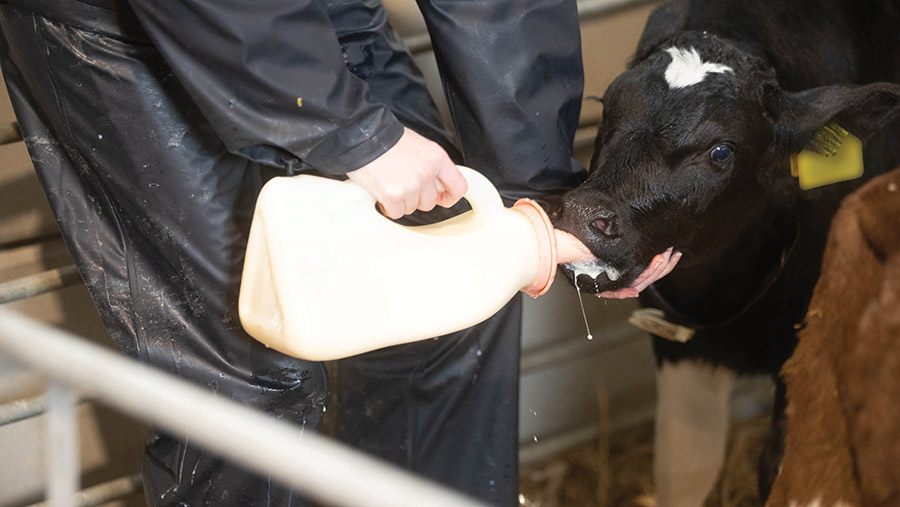How to make routine dairy tasks easier with a calf kitchen
 © Tim Scrivener
© Tim Scrivener Making it easy to carry out routine tasks is essential to optimise calf health, welfare and productivity. Emily Linton of Torch Farm Vets offers expert advice.
I walked onto a farm last summer to find the calf rearer scrubbing the calf feeding buckets. Being a calf health enthusiast, things like this make me very happy, so I commented: “That looks like a good job”.
The reply: “Well, it’s got to be done sometimes” was like a pin piercing my little bubble of happiness – you could almost hear it deflating.
About the author

Emily Linton BVSc Cert AVP (Cattle) MRCVS is a vet at Torch Farm Vets. She has a certificate in cattle health and production and is an AHDB mobility mentor. She enjoys all aspects of cattle work but is particularly interested in lameness prevention and youngstock health.
Fortunately, I go to many farms where the washing of calf buckets after each feed (just like we wash our plates and cutlery after every meal), and other good practices, are part of the daily routine.
But I still visit too many where it is not.
See also: 9 tips on maximising calf health and minimising mortality
I know many farmers are time-poor, often as a result of labour shortages, but ensuring we get the basics right is essential to rearing happy, healthy calves that go on to live long and productive lives.
If we can find a way to make routine tasks as easy as possible, it is far more likely they will get done.
This is why I like to talk about the “calf kitchen”. In an ideal world, this would be a purpose-built structure where everything required is housed in the same place, but this is not essential.
It can simply be a collection of equipment and supplies that are close at hand and easy to use. The essentials are listed below.
Working fridge/freezer
Calves are born with little to no immune defences, so feeding the correct quantity of good-quality colostrum, quickly, is paramount.
But that colostrum has the potential to do more harm than good if it is fed full of bacteria or through dirty feeding equipment.
In warm colostrum, bacterial numbers can double every 20 minutes, which is why fresh colostrum should be fed to calves within one hour of collection or stored appropriately (see “How long colostrum can be stored in different ways”).
How long colostrum can be stored in different ways |
||
|
|
Refrigeration |
Freezing |
|
Length of storage |
24 hours |
Up to one year |
|
Storage method |
1-2 litre containers |
1-2 litre zip bags/purpose-made flat |
|
Storage temperature |
4C |
-18C to -20C |
|
Source: AHDB |
||
Working set of scales
Consistency is king when it comes to feeding calves. Powder weighs less at the top of a bag than the bottom so using a scoop or jug is not an accurate method.
The weighing of powder needs to be built into the daily routine.
Access to warm water
This is essential for mixing milk replacer and to allow an adequate level of cleaning.
The fitting of a mixer tap to ensure there is always a constant temperature for mixing milk powder is an excellent way to save labour and maintain consistency.
However, try to avoid having the tap inside the calf shed because it creates water vapour, which can negatively affect the calves’ environment.
Cleaning protocol that involves both disinfectant and detergent
Milk is a great for growing calves – and humans – but it is also great for growing bacteria.
Buckets and equipment need to be washed using a detergent before disinfecting them, to avoid the creation of a harmful but invisible biofilm.
Feed For Growth(PDF) is a great resource on how to create an effective cleaning routine.
Drying rack
Drying is another great way to kill bacteria, but that will not happen if buckets are stacked on top of each other or left upturned on the floor.
A simple drying rack created by fixing hooks on the wall can be an easy way to achieve this.
Alternatively, a customised drying trolley can be made on farm and wheeled indoors or out, depending on the weather.
Board for protocols
Having clear protocols for everyone to follow means high standards and consistency are more likely to be maintained. Consider separate instructions for colostrum storage, washing procedures, and mixing amounts for different numbers of calves.
Hygiene, consistency, and attention to detail are just as important when feeding whole milk or using automatic feeders.
If these things are done correctly on a daily basis, we minimise the risk of scour, reduce the risk of pneumonia by not having immunocompromised calves and help to maximise daily liveweight gain.
Whether heifer replacements or dairy-beef calves are being reared, the key is to make it easy to do the right thing. Any concerns can be discussed with your vet.
Calf kitchen dos and don’ts
Do:
- Provide a specific area for preparing milk and washing buckets
- Have access to hot water
- Follow a wash-up routine that includes detergent and disinfectant
- Provide a place where buckets can dry properly
- Use a working fridge
- Weigh with a working set of scales
- Set up and follow protocols for all routine procedures such as feeding, cleaning and storing colostrum, and provide easy access to the equipment needed to carry them out
Don’t:
- Clean buckets in the calf house
- Leave milk to grow bacteria in buckets between feeds
- Guess how much milk powder is needed or just use a jug
- Leave colostrum out in an open bucket
